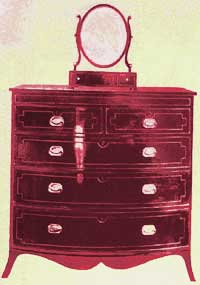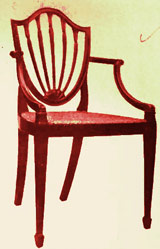Hepplewhite Furniture
George Hepplewhite’s furniture marked the transition from the Chippendale to the classic influence. Hepplewhite designed and built a significant amount of furniture, however his output was not as great as that of Chippendale.
Although Hepplewhite was never as thorough a classicist as Adam or Sheraton, his furniture pieces became very popular between 1765 and 1775. His book of design, "The Cabinet-Maker and Upholsterer's Guide," appeared in 1789, two years after his death.
Hepplewhite enriched the Georgian style furniture with his shield-shaped chair backs, their square legs often ending in the spade foot, and his splendid sideboards.

Hepplewhite: Chest of Drawers, Mahogany
The sideboard evolved substantially during the later years of the Chippendale’s period, but Hepplewhite and Shearer, his contemporary, brought this piece of furniture to perfection. Hepplewhite also made wardrobes that supplanted the old highboy, dressing tables with heart shaped mirrors, and cabinets with long, tapering legs. His chairs, remarkable for the beauty of the curves and their proportion, were mostly made with the shield or oval backs. The seats were usually upholstered.
Hepplewhite preferred mahogany for most of his furniture. For special orders, on a lesser scale, he used satinwood and rosewood as well. He was not a great carver like Chippendale, nor so finished an artist in inlay as was Sheraton, but he skillfully employed both carving and inlay with great success. His sideboards, especially, were often embellished with fine, delicate inlay of satinwood, tulipwood, sycamore, rosewood, maple, yew, holly, and ebony, with little or no carving. He extensively used delicate vertical patterns on the legs of tables and sideboards. The favourite motifs were the straight parallel lines, the husk, the wheat-ear, the meander pattern, and the Greek fret.
The carving of his furniture was well executed and in low relief. The main motifs were the wheat-ear, the draped urn, and the three feathers of the Prince of Wales used mostly on his oval chair backs. The four-poster beds created by Hepplewhite are special, as their construction is more graceful and lighter than that of the previous styles.

Hepplewhite Style Armchair
Mahogany
Thomas Shearer, another Georgian master, was active during the same period. His work has been somehow overshadowed by that of Hepplewhite. To do him justice, we should note that he created pieces which were almost equal to Hepplewhite's, and, in the matter of sideboards, he surpassed him. Shearer is credited with the creation of the serpentine front. He specialized in sideboards, bookcases, and desks with secret drawers, similar to those made by Sheraton. The number of chairs attributed to him is rather small.
Overall, as demonstrated also by Shearer’s "Designs of Household Furniture," published in 1791, his style was similar to that of Hepplewhite, still a bit heavier.
